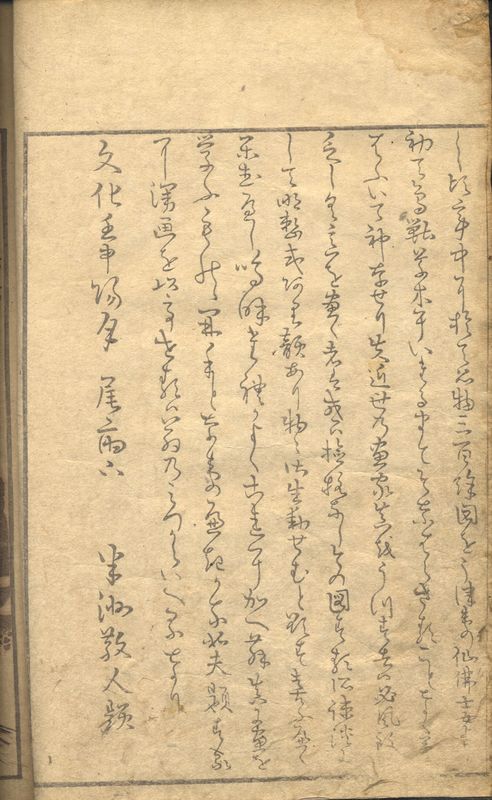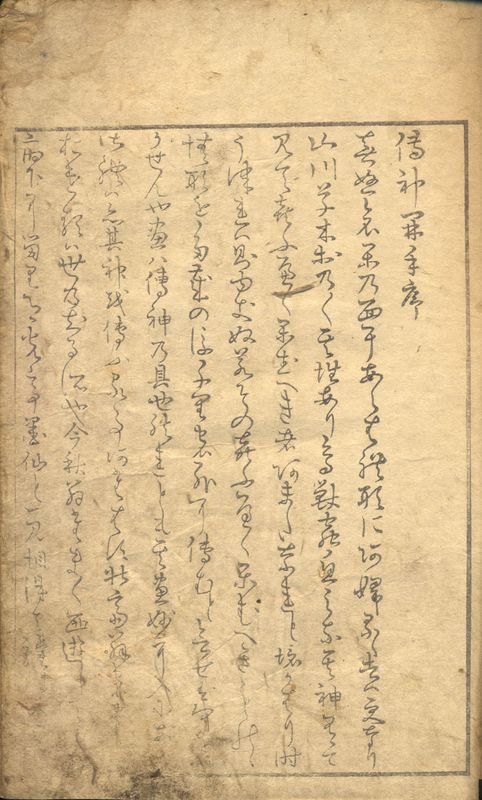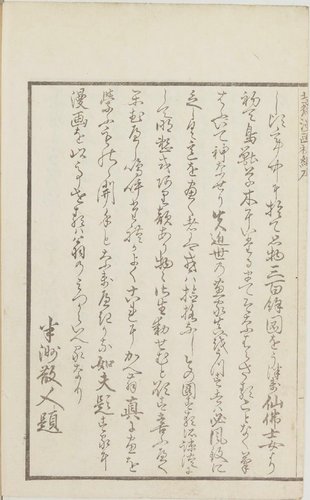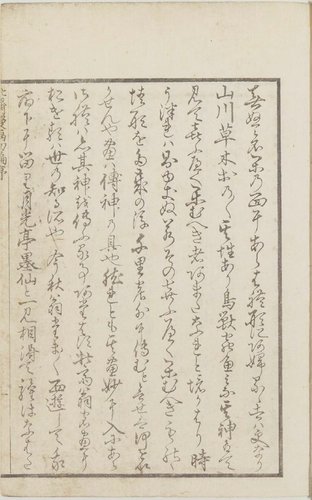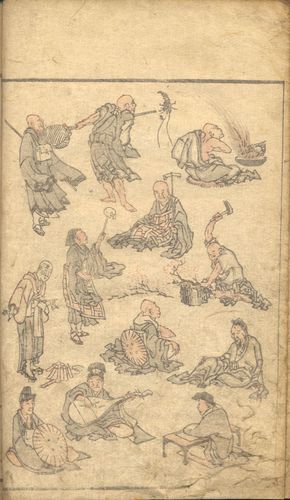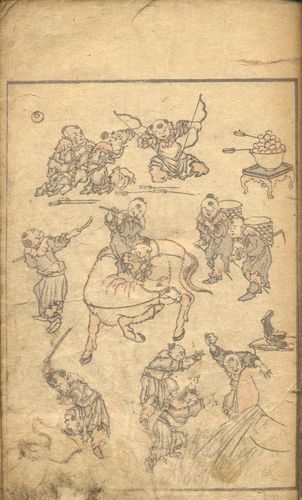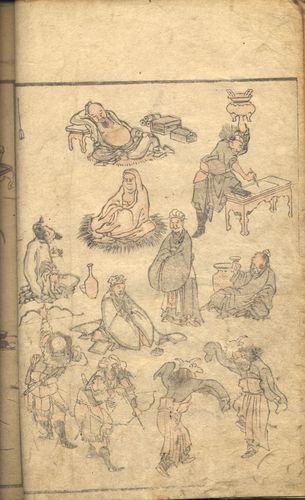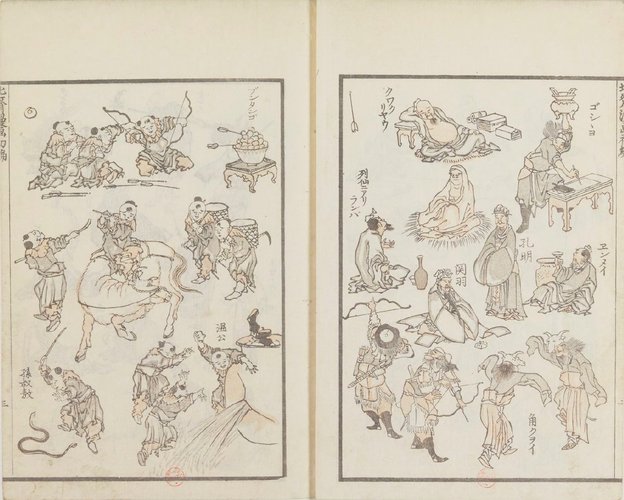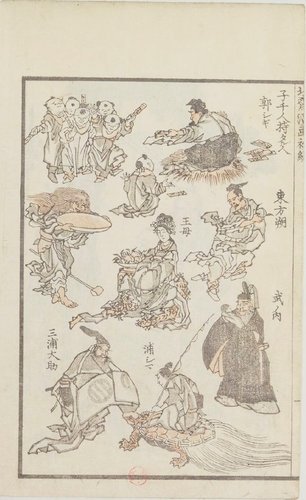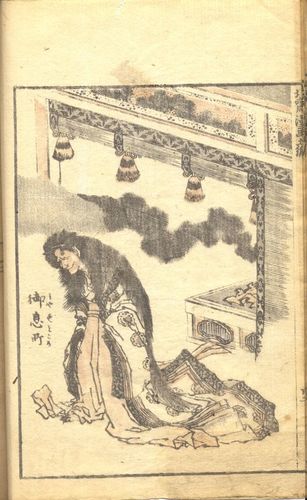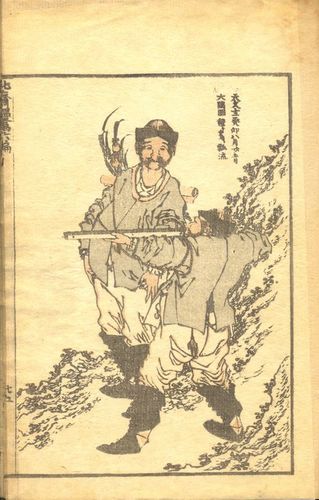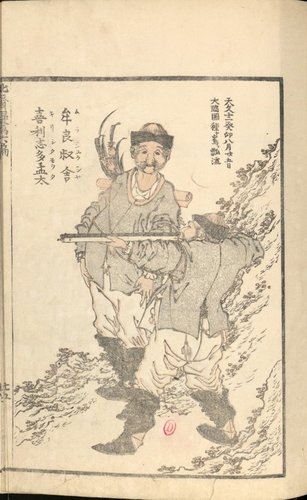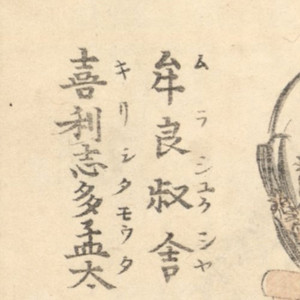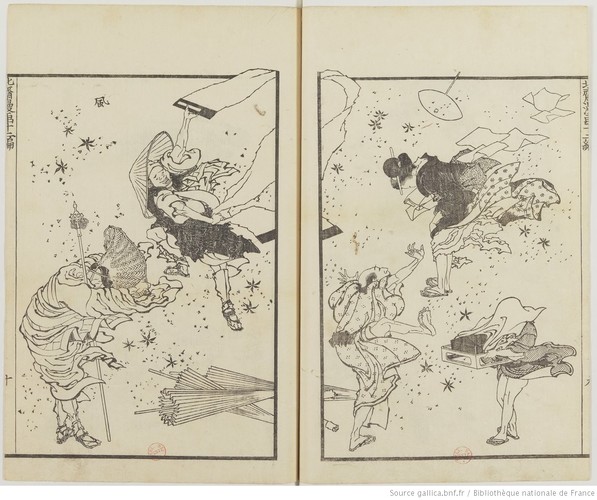Differences between editions
of Hokusai Manga
The differences between editions are of course very minor and only of interest to specialists. They deserve nevertheless to be pointed out, since they can help in attributing a date of publication. Most differences are in the cover, the fukuro and the colophon. The date of publication, when available, is in the colophon. Otherwise, the advertisements on the cover page and at the end of the volume can be helpful for identifying the date of publication. The fact that the name of the eastern capital changed from Edo to Tokyo in 1868 can also help. The name of the publisher can also be found in the colophon, or through the advertisements, but this name is not useful for dating a volume, since the two Edo era publishers used the same woodblocks.
When present, the advertisements will perhaps tell you when the book was printed, but this might be a new printing of the edition, at a later date. Volumes 1 to 7 from the British Museum, which are first editions according to their colophons, carry advertisements for all ten volumes, the content of which implies that these are later printings, or should one call them unrevised editions? (see our links page). A further difficulty is that the book may have been put together (or restored) at a later date using sheets taken from different sources. Three examples : volume 1 of the Pulverer Collection at the Freer Gallery of Art has no captions, but a revised preface; one of our copies of volume 3 has the wrong preface (that of volume 6); the date of publication listed on the colophon of a volume 8 from Gallica is Bunka 13 (1816), which is too early for the first edition of that volume. Interestingly, Silvia Faccioli mentions a similar problem with one of the copies of volume 8 available to her (Faccioli, 2003, p. 53).
Most differences listed below were pointed out by Faccioli (2003). Since most changes occurred in the Edo era editions, which are difficult to date, she only states that the changes occurred in "later editions".
Volume 1
Two simultaneous changes occurred in a later edition of volume 1, which remained permanently thereafter, including in the Meiji edition. The changes are present in a Gallica copy (the one labelled 1c in the links page), but not in the INHA copy.
|
|
||||||||||||
The preface was redrawn and recarved. In the new preface, the title (5 first kanjis) and the date (kanjis before the signature in the last column) are omitted. We have not translated the title of the preface, because there are many ways of understanding it. Evgeny Steiner (2014) discusses the matter in detail and proposes that Denshin kaishu should be understood as "the transmission of spirit and opening of skills".
|
||||||||
|
||||||||
The other change is the addition of captions, but only on the first few pages, and of the book title in the margin. Silvia Faccioli suggests that Hokusai at first did not deem it useful to explain the images, and that the publisher might have convinced him of the contrary, as captions appear in all the following volumes and re-editions.
The advertisements at the end of the copies from Gallica and INHA both list the first ten volumes of Hokusai Manga. Since volume 10 was published in 1819 and volume 11 probably around 1834, we first assumed that the two sets of mangas were published in the years 1819-1834. Now the fukuro of the Meiji edition of vol. 1 (with the changed preface and added captions) states that it is a reprinting of the edition of Bunsei 11 spring, or spring of 1828 (see Faccioli, p.90), so the changes must have occurred in 1828 at the latest. The range of dates for the INHA copy then becomes 1819-1828, and that for the Gallica copy 1828-1834.
Volume 5
|
|
On page 2v of our copy the red seal is displaced to the middle of the page and a bit higher. This change is absent from most editions, even the Meiji one. This seal is not of the kind added later by an art collector or merchant. The latter kind of seal can be seen on volumes 3 and 9 of the INHA collection and on the copies at the National Diet Library.
|
|
The advertisement in our copy lists the book 大日本國郡全圖 (Dai Nippon Kokugun zenzu, saishikizuri, hako iri, zen nisatsu or "Complete map of the Great Japan districts, color illustrations, inserted in a slip case, two volumes"). published in 1848, so at least the first change mentioned here occurred after that date (unless 1848 is the date of a re-edition).
Waseda University Library has a copy identical to ours, with an advertisement for Kyoga Shinji andon (festival lanterns), author Shotei Shujin, published in 1829-1847.
The British Museum has a copy dated 1829, and the Museum of Fine Arts (Boston) has one dated "around 1829", but unfortunately no images are available. One possibility is that the change of name occurred in 1829 and was implemented in all later editions, while the displacement of the seal occurred only in one edition, around 1848.
Volume 6
|
|
|
On page 25r, the names of two foreigners, 牟艮叔舎 (Murashukurishiya) and 喜利志多孟太 (Kirishitamota), present in the first edition and in the INHA one from 1819-1834, are missing in other editions of the period 1819-1834 (the Gallica edition for example) and in our Meiji edition. According to Silvia Faccioli, they were censored because of the dislike of foreigners, especially one with a name almost like "Christian".
Volume 7
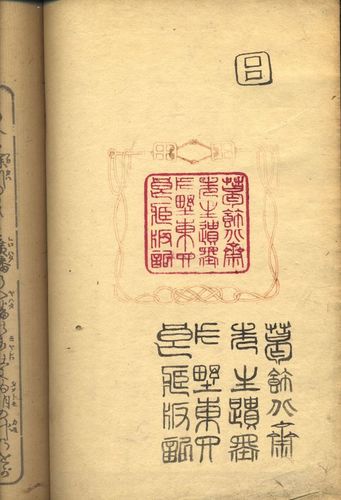 |
|
| Back of the fukuro page of our copy | |
There are two seals on the verso of our copy's fukuro. The red one is on all the Meiji era editions of the Mangas. The black one is seen nowhere else on Meiji era copies available to us; it is not a collector's or owner's seal, but a publisher's seal since it is identical to the red one, which carries the names of Katsuchika Hokusai (葛飾北斎 first column from the right) and Katano Toshiro (片野東四 third column, 郎 top fourth column).
Volume 11
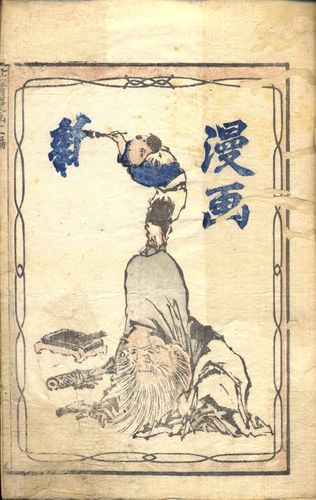 |
| frontispiece of our copy |
On the frontispiece of our copy, the three kanjis 新漫画 (shin man ga, which can be translated as "new random pictures") and the top of the young boy painting them are colored in blue, rather than in grey. This frontispiece is identical to the one of the 1973 edition.
For a discussion of the translation of the term Manga, see Steiner (2014).
Volume 12
Colors were added to all the images in later editions of this volume.
|
|
Furthermore, a wind was added in grayscale to the images of pages 9v-10r in later editions.
 |
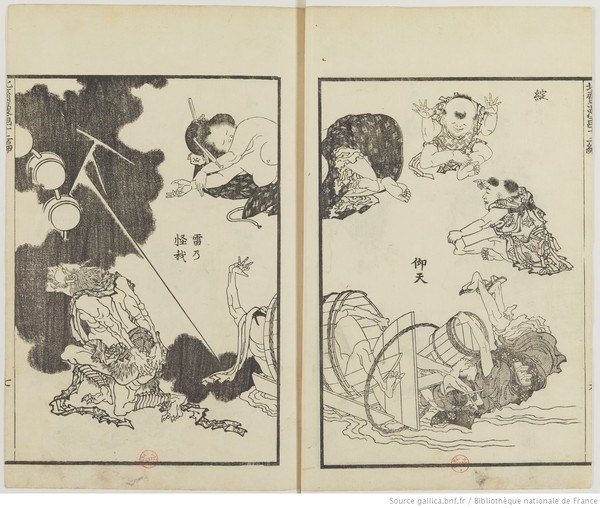 |
| page 6v-7r, Uncolored edition from Pulverer |
page 6v-7r, Uncolored edition from Gallica |
Faccioli (2003) mentions that the dress of the woman at the top of pages 6v-7r is ripped in the first edition, and that this was changed in later editions. The only case of ripped dress was found in the copy of the Pulverer collection.
Colors were added to the pictures in later editions of volumes 13 and 14.
As already mentioned, a fukuro was added in most volumes of the Meiji 1878 edition, with a large red seal on the verso page, which makes that edition easily identifiable. The years given on the fukuros are in the sexagesimal cycle, the mention of the era removes the ambiguity.
 |
 |
 |
 |
| daisen 1 (vol.5) |
daisen 1 (vol.11) |
daisen 2 (vol.6) |
daisen 3 (vol.15) |
A last difference concerns the title piece (daisen 題簽) on the front cover. On the daisens of some copies of the Manga published after 1849, the title denshin kaishu (daisen 1) is replaced by Katsuchika Iitsu iboku (brushwork of the deceased Katsuchika Iitsu), (daisen 2). This occurs in our copy of vol.6, volumes 1-14 of the National Diet Library, and vol. 14 of the British Museum. On the daisens of some Meiji era copies of vol.15, denshin kaishu is replaced by Katano Toshiro henshu (compiled by Katano Toshiro), (daisen 3).
Bibliography
Faccioli, Silvia, I manga di Hokusai, Analisi cronologica delle edizioni e relative sequenze di uscita, Tesi di Laurea, Università Ca' Foscari di Venezia, 2003, 160p.
Forrer, Matthi, Hokusai. La Manga. L’Édition Complète Commentée 2 volumes, Paris, editions Hazan, 2014.
Steiner, Evgeny, Endlessly variegated pictures: a pictorial encyclopedia of old Japanese life (an introduction to Hokusai Manga’s full edition with commentaries), National Research University, Higher School of Economics, 2004, 33p.
https://www.hse.ru/data/2014/04/28/1322671198/49HUM2014.pdf

